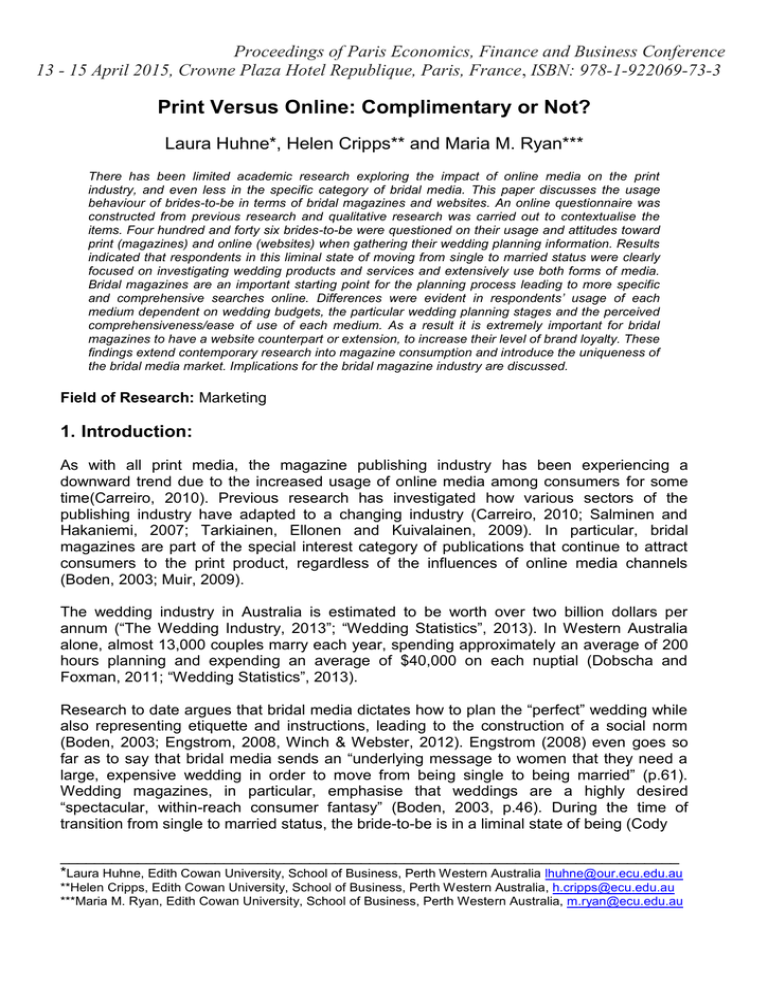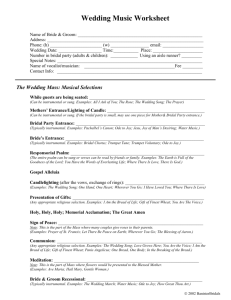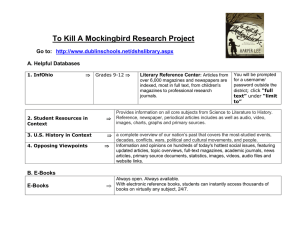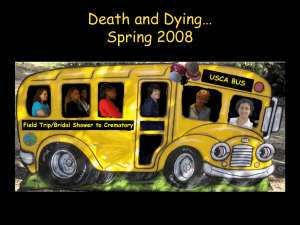
Proceedings of Paris Economics, Finance and Business Conference
13 - 15 April 2015, Crowne Plaza Hotel Republique, Paris, France, ISBN: 978-1-922069-73-3
Print Versus Online: Complimentary or Not?
Laura Huhne*, Helen Cripps** and Maria M. Ryan***
There has been limited academic research exploring the impact of online media on the print
industry, and even less in the specific category of bridal media. This paper discusses the usage
behaviour of brides-to-be in terms of bridal magazines and websites. An online questionnaire was
constructed from previous research and qualitative research was carried out to contextualise the
items. Four hundred and forty six brides-to-be were questioned on their usage and attitudes toward
print (magazines) and online (websites) when gathering their wedding planning information. Results
indicated that respondents in this liminal state of moving from single to married status were clearly
focused on investigating wedding products and services and extensively use both forms of media.
Bridal magazines are an important starting point for the planning process leading to more specific
and comprehensive searches online. Differences were evident in respondents’ usage of each
medium dependent on wedding budgets, the particular wedding planning stages and the perceived
comprehensiveness/ease of use of each medium. As a result it is extremely important for bridal
magazines to have a website counterpart or extension, to increase their level of brand loyalty. These
findings extend contemporary research into magazine consumption and introduce the uniqueness of
the bridal media market. Implications for the bridal magazine industry are discussed.
Field of Research: Marketing
1. Introduction:
As with all print media, the magazine publishing industry has been experiencing a
downward trend due to the increased usage of online media among consumers for some
time(Carreiro, 2010). Previous research has investigated how various sectors of the
publishing industry have adapted to a changing industry (Carreiro, 2010; Salminen and
Hakaniemi, 2007; Tarkiainen, Ellonen and Kuivalainen, 2009). In particular, bridal
magazines are part of the special interest category of publications that continue to attract
consumers to the print product, regardless of the influences of online media channels
(Boden, 2003; Muir, 2009).
The wedding industry in Australia is estimated to be worth over two billion dollars per
annum (“The Wedding Industry, 2013”; “Wedding Statistics”, 2013). In Western Australia
alone, almost 13,000 couples marry each year, spending approximately an average of 200
hours planning and expending an average of $40,000 on each nuptial (Dobscha and
Foxman, 2011; “Wedding Statistics”, 2013).
Research to date argues that bridal media dictates how to plan the “perfect” wedding while
also representing etiquette and instructions, leading to the construction of a social norm
(Boden, 2003; Engstrom, 2008, Winch & Webster, 2012). Engstrom (2008) even goes so
far as to say that bridal media sends an “underlying message to women that they need a
large, expensive wedding in order to move from being single to being married” (p.61).
Wedding magazines, in particular, emphasise that weddings are a highly desired
“spectacular, within-reach consumer fantasy” (Boden, 2003, p.46). During the time of
transition from single to married status, the bride-to-be is in a liminal state of being (Cody
________________________________________________________________________
*Laura Huhne, Edith Cowan University, School of Business, Perth Western Australia lhuhne@our.ecu.edu.au
**Helen Cripps, Edith Cowan University, School of Business, Perth Western Australia, h.cripps@ecu.edu.au
***Maria M. Ryan, Edith Cowan University, School of Business, Perth Western Australia, m.ryan@ecu.edu.au
Proceedings of Paris Economics, Finance and Business Conference
13 - 15 April 2015, Crowne Plaza Hotel Republique, Paris, France, ISBN: 978-1-922069-73-3
and Lawlor, 2011), displaying a combination of a rational project manager self with a childlike dreamer (Boden, 2003; Otnes, Lowrey and Shrum, 1997). Academic research to date,
has not investigated the range of different tools used by engaged women for wedding
planning purposes (Engstrom, 2008).
Brides are a prime target market involved in an extraordinary life experience with wedding
planning being a high cost involved activity in terms of both time and money (Wu, et al,
2013). More specifically, there has been little if any scholarly investigation into what factors
influence the usage of bridal magazines, and if new developments in online media have
affected the way consumers use and perceive these media channels (Blakely, 2008; Muir,
2009). In Australia, similarly to the developing world around the globe, the magazine
publishing industry is currently experiencing a downward trend due to the increased usage
of online media among consumers (Carreiro, 2010). Previous research shows how various
categories of the publishing industry have adapted and progressed through this change in
industry business logic (Carreiro, 2010; Salminen and Hakaniemi, 2007; Tarkiainen,
Ellonen and Kuivalainen, 2009). Although this research provides insights for the bridal
magazine industry, bridal magazines appear to be a unique category that continues to
attract consumers to the print product; regardless of the influences of online media
channels due to it highly involved target audience (Boden, 2003; Jackson, 2011; Muir,
2009).
A number of studies to date have compared print and online media and suggest that printed
materials are becoming obsolete (Flavián and Gurrea, 2006; Kaiser and Kongsted, 2012;
Malhotra, 2008; Nienstedt, Huber and Seelmann, 2012). Others such as Carreiro (2010),
Salminen and Hakaniemi (2007) and Tarkiainen et al., (2009) all argue that online
extensions or additions actually complement their printed versions. Furthermore, research
indicates that in today‟s society, multi-channel media extensions are essential to keep up
with demand from consumers in a highly competitive print publishing industry (Nienstedt et
al., 2012; Salminen and Hakaniemi, 2007; Salo et al., 2013).
A recent development in the publishing industry is the extension and introduction of social
media networks. This includes but is not limited to Facebook, Twitter, Pinterest, Google+,
Instagram, Snapchat and LinkedIn. These are forms of two-way communication used by
brands to directly communicate with consumers and vice versa. Social media is often used
in the publishing industry for relationship building (Ellonen et al., 2010). It is becoming
increasingly more important to have an online social presence, however academic research
is catching up on this novel phenomenon (Kumar and Mirchandani, 2012; Rishika, Kumar,
Janakiraman and Bezawada, 2013; Zauner, Koller and Fink, 2012).
The purchase of magazines is a well-researched facet of consumer behaviour that is
associated with experiences of leisure, inspiration and tradition (Davidson et al., 2007;
Regout, 2011; Solomon, 2009). There has been little academic research attempting to
Proceedings of Paris Economics, Finance and Business Conference
13 - 15 April 2015, Crowne Plaza Hotel Republique, Paris, France, ISBN: 978-1-922069-73-3
understand the use of bridal magazines and wedding websites and social media platforms
such as Pinterest. This study aims to discover the attitudes towards using print and online
materials by brides-to-be within their unique journey of planning a wedding.
2. Research Questions and Literature Review
This study focuses on four main determinants identified in previous literature used to
examine the attitudes towards using online and print media (Gregory, 2008; Stevens,
Maclaran & Catterall, 2007; Stevens & Maclaran, 2005; Tarkiainen et al., 2009). The
determinants used in this research were chosen from studies that investigated offline and
online consumer behaviour (Carreiro, 2010; Ytre-Arne (2011) and were considered most
appropriate for investigating bridal media. This includes channel attributes, emotional
experiences, demographics and their usage levels of each (Vijayasarathy, 2004; Srisuwan
and Barnes, 2008; Regout, 2011). The following paragraphs outline three of these aspects
with the associated research question for this study.
2.1.
Channel Attributes
Channel attributes define the individual benefits and/or disadvantages of print and online
media. Each media channel has a long list of attributes attached to its use, including but not
limited to comprehensiveness/ease of use, sensory systems and information overload
(Salminen and Hakaniemi, 2007; Tarkiainen et al., 2009; Ytre-Arne, 2011; Ellonen et al.,
2010; Gregory, 2008; Salo et al., 2013; Vijayasarathy, 2004; Regout, 2011). The attitudes
and perception toward specific channel attributes determines whether or not a consumer
will prefer to use them over another media channel (Srisuwan and Barnes, 2008). RQ1: Do
channel attributes influence consumer’s attitudes towards bridal magazines and websites?
2.2
Emotional Experiences
Stevens et al. (2007) claims that interest-specific magazines have sustained their
desirability since their inception in the eighteenth century, due to their tangibility and
emotive properties, which are continuously desired in a print form by the consumer.
However, it is uncertain whether this still applies in today‟s society as the industry is
experiencing multiple changes in technology, in which consumers are actively and rapidly
adapting to. Enjoyment is a key aspect of emotional experiences. The channel with the
most enjoyable properties tends to be the media that is most used (Solomon, 2009).
Proceedings of Paris Economics, Finance and Business Conference
13 - 15 April 2015, Crowne Plaza Hotel Republique, Paris, France, ISBN: 978-1-922069-73-3
Enjoyment can be experienced through both by browsing online or flipping through the
pages of a magazine. It appears online media has become more frequently used as a pasttime. RQ2: Do emotional experiences influence consumer’s attitudes towards bridal
magazines and websites?
2.3
Usage levels
Existing research has investigated the relationship between print and online media across
magazines generally. The focus has previously been on the usage levels of magazines and
websites and whether consumers will continue to use and purchase magazines when
content is so widely available online (Ellonen et al., 2010; Kaiser and Kongsted, 2012;
Nienstedt et al., 2012; Srisuwan, and Barnes, 2008; Tarkiainen et al., 2009;). These
questions have not been examined in the category of bridal magazines. Bridal magazines
are unique as they are normally published annually, with over three hundred pages and rely
on emotional appeals to attract a highly targeted consumer market during a significant life
event. Bridal magazines “give meanings to the pre-wedding build-up as well as the day
itself.” (Boden, 2003, p.46). RQ3: What is the level of usage bridal magazines and
websites, and do consumers use them exclusively or interchangeably?
3. Methodology
A quantitative questionnaire was developed using scales previously available in the
literature and developed appropriately and tested (via a focus group of brides-to-be) for the
bridal market. Regout (2011) developed a scale for determining the usage of bridal
magazines and websites. The questionnaire also included dimensions derived from a study
by Vijayasarathy, (2004), who used the Technology Acceptance Model (TAM) that impacts
the use of online versus offline processes in the retail industry. They determined the main
influencing factors were ease of use and usefulness of a medium. All items of the
questionnaire derived from previous research substituted their research context with bridal
magazines. (e.g. “The internet gives me access to useful shopping information”, was
adapted to “Bridal websites/Bridal magazines give me access to useful wedding planning
information”) The questionnaire utilised a series of Likert Scales ranging from “1= strongly
disagree” to “6= strongly agree” to determine respondents‟ attitudes towards statements.
The questionnaire link was displayed on Facebook page, a local bridal magazine‟s website,
Proceedings of Paris Economics, Finance and Business Conference
13 - 15 April 2015, Crowne Plaza Hotel Republique, Paris, France, ISBN: 978-1-922069-73-3
and an email campaign to their client database of engaged women. Data collection was for
a period of two weeks. In addition promotional strategies such as Facebook advertising
and prize incentives were used to collect a sufficient amount of completed questionnaires.
The final sample totalled 446 respondents. Once data collection was finalised, it was
imported into SPSS for descriptive and statistical data analysis.
4. Findings
4.1
Sample
All respondents were female with the majority (96.9%) engaged to be married or otherwise
married within the last two years. All respondents were Australian citizens, with slightly
more than half of the respondents (51.1%) were between 25 and 30 years old,
predominately working full time (66.8%), with majority of their partners also working full-time
(90.8%). The total budget for the wedding ranged from $10,000 to $50,000 or more, but the
majority (63.6%) expected to spend around $10,000 to $30,000 on their wedding day. The
majority of respondents (94.7%) were planning their first wedding with only 5.3 per cent of
respondents planning their second or third wedding. Furthermore, more than half of
respondents (52.2%) considered themselves a medium internet user while 34.8 per cent
were heavy; with the remaining 13 per cent indicated they were low internet users.
4.2
Channel Attributes
A Principle Component Analysis (PCA) was conducted to reveal the underlying dimensions
with scale items for use and attitudes toward both print and online media. The PCA
revealed five factors with eigenvalues equalling to or exceeding one (Hair, Bush & Ortinau
(2009). These included comprehensive/ease of use, sensory systems, keepsake aspect
(only for print media), information overload and enjoyment. These five factors explained 69
per cent of the variance within the data. A comparison between print and online sources
revealed a number of aspects; these are illustrated in Table 1 and discussed in the
following paragraphs.
Proceedings of Paris Economics, Finance and Business Conference
13 - 15 April 2015, Crowne Plaza Hotel Republique, Paris, France, ISBN: 978-1-922069-73-3
As evident in Table 1, websites had a mean score of 5.23 for comprehensive and ease of
use, significantly higher than magazines with a mean of 3.91. On the opposite end of the
spectrum, the factor „information overload‟ contained negative items such as frustrating and
cumbersome and here the websites again achieve a higher - more negative score (3.62)
than bridal magazines (2.88). Ironically, websites are seen as comprehensive and easy to
use but also come with the connotation of creating information overload and experience
common to brides to be (Otnes et al., 1997). Sensory systems focused on the look and feel
of using bridal magazines and websites. Both media scored high across all sensory items,
with respondents indicating a marginally higher preference for the sensory aspects of
magazines over that of websites, but the differences between these components are
minimal and suggesting although statistically significant of minimum practical significance.
Table 1: Factor Mean Scores - Magazines & Websites
Bridal
Magazines
Factors
N
M
u
e
m
a
b
n
e
r
S
D
o
f
M
e
a
n
S
D
0
.
8
8
*
1
.
0
9
*
*
1
.
2
7
I
t
e
m
s
I
t
e
m
s
Channel
Attributes
Comprehensive/
Ease of Use
Bridal
Websites
N
u
m
b
e
r
o
f
9
3
.
9
1
1
.
3
8
5
.
2
3
Sensory
Systems
5
4
.
6
7
1
.
1
5
4
.
5
1
Information
Overload
3
2
.
8
8
1
.
2
4
3
.
6
2
Proceedings of Paris Economics, Finance and Business Conference
13 - 15 April 2015, Crowne Plaza Hotel Republique, Paris, France, ISBN: 978-1-922069-73-3
*
*
Emotional
Experiences
Enjoyment
2
Keepsake
2
* = Significant at the p<=0.05 level
4
.
4
3
3
.
0
8
1
.
2
3
1
.
6
N
/
A
4
.
2
8
-
1
.
2
7
-
** = Significant at the p<=0.01 level
The aspect of enjoyment is fairly equal in both magazines and websites as the differences
in the combined mean score (shown in Table 1) is minor. The aspect of reading on a
particular medium had stronger preferences in magazines than websites; however,
websites had slightly higher agreement to having an enjoyable pastime/distracting state.
Bridal magazines were identified as a keepsake in the literature and an important aspect of
their use. The data did not show strong intentions of retaining bridal magazines as a
keepsake of their planning experiences with a mean score of 3.08 and a relatively high
standard deviation of 1.67. There appears to be a large variation in responses with half of
respondents indicating they do not intend to keep their bridal magazines for more than 6
months after their wedding. Conversely, a large second group (n=100) intend to keep them
indefinitely.
The same respondent who uses magazines is also highly likely to use websites in a similar
manner to gather additional wedding information and/or inspiration. This suggests the two
forms of media are used interchangeably rather than exclusively. The key finding here is
the time frame in which magazines are used as opposed to websites. The majority (53.5%)
of respondents used bridal magazines predominately during the beginning stage of their
engagement, while the large majority (69.2%) use websites throughout their engagement
period to gather wedding information.
5. Conclusion
It is essential that the publishing industry adapt to this new changing market with desires for
both media. The industry needs to understand their new audience and modify their
Proceedings of Paris Economics, Finance and Business Conference
13 - 15 April 2015, Crowne Plaza Hotel Republique, Paris, France, ISBN: 978-1-922069-73-3
product(s) accordingly. The content provided through various digital media channels
creates additional brand awareness and the prospect of extended brand loyalty. This allows
companies to retain brand loyalty from their consumers across multiple channels rather
than forcing them to choose one brand for each media channel (Carreiro, 2012; Nienstedt
et al., 2012). Consistent presence across various media channels creates a strong
competitive advantage by being in all places at all times (Ellonen et al., 2010). The current
study indicated bridal magazines continue to be purchased, despite the growth of bridal
websites. The lack of variance between the two may be explained by the possibility of
magazines being used as an important starting point for gathering wedding planning
inspiration and ideas and leading to more specific and comprehensive searches online. The
interchangeable nature of the two media should not be underestimated by the bridal media
industry as websites play a very important role in the wedding planning journey and support
the viability of bridal magazines. As a result, it is extremely important for bridal magazines
to have a website counterpart or extension, to increase the level of brand loyalty.
Embracing the use of both media could provide greater sustainability for the industry as a
whole.
6. References
Blakely, K. 2008, Busy Brides and the Business of Family Life: The Wedding-Planning
Industry and the Commodity Frontier, Journal of Family Issues, Vol. 29, No. 5, pp. 639-662.
Boden, S. 2003, Consumerism, romance and the wedding experience. GB: Palgrave
Macmillan Ltd.
Carreiro, E. 2010, Electronic books: How digital devices and supplementary new
technologies are changing the face of the publishing industry. Publishing Research
Quarterly, Vol. 26 No. 4, p. 219.
Cody, K and Lawlor, K. 2011, On the borderline: Exploring liminal consumption and the
negotiation of threshold selves. Marketing Theory. 11(2), 207-228.
Davidson, L., McNeill, L. and Ferguson, S. 2007, Magazine communities: Brand community
formation in magazine consumption. International Journal of Sociology and Social Policy,
Vol. 27 No. 5/6, pp. 208-220.
Dobscha, S. and Foxman, E. 2011, Mythic agency and retail conquest. Journal of Retailing,
Vol. 88 No. 2, p. 291.
Ellonen, H., Tarkiainen, A. and Kuivalainen, O. 2010, The effect of magazine website usage
on print magazine loyalty. International Journal on Media Management, Vol. 12 No. 1, pp.
21-37
Engstrom, E. 2008, Unravelling the knot: Political economy and cultural hegemony in
wedding media. Journal of Communication Inquiry, Vol. 32 No. 1, pp. 60-82.
Proceedings of Paris Economics, Finance and Business Conference
13 - 15 April 2015, Crowne Plaza Hotel Republique, Paris, France, ISBN: 978-1-922069-73-3
Flavián, C. and Gurrea, R. 2006, The choice of digital newspapers: Influence of reader
goals and user experience. Internet Research, Vol. 16 No. 3, pp. 231-247.
Gregory, C. 2008, But I want a real book: An investigation of undergraduates' usage and
attitudes toward electronic books, Reference & User Services Quarterly, Vol. 47, No. 3,
pp266-275.
Hair, J. F., Bush, R. P. and Ortinau, D. J. 2009, Marketing research: In a digital information
environment. Boston: McGraw-Hill Irwin.
Jackson, S. 2011, “Magazines are in favour, but bridal‟s the business”, available at:
http://www.theaustralian.com.au/media
/magazines-are-in-favour-but-bridals-thebusiness/story-e6frg996-1226009079545 (accessed 18 May 2013).
Kaiser, U., & Kongsted, H. 2012, Magazine "companion websites" and the demand for
newsstand sales and subscriptions. Journal of Media Economics, 25(4), 184.
Kumar, V. and Mirchandani, R. 2012, Increasing the ROI of social media marketing. MIT
Sloan Management Review, Vol. 54 No. 1, pp. 55-61.
Lavrakas, P. 2008, Likert Scale. Encyclopedia of Survey Research Methods.
Malhotra, S. 2008, Interview with Sandeep Malhotra, head of the vertical solutions group in
HCL technologies-supply-chain strategies for the publishing industry. Journal of Digital
Asset Management, Vol. 4 No. 1, pp. 32-41.
Muir, C. 2009,"Bridal Website/Blogs vs Print Magazines" Master of Science in Publishing.
Paper 2. Nienstedt, H., Huber, F. and Seelmann, C. (2012), The influence of the
congruence between brand and consumer personality on the loyalty to print and online
issues of magazine brands. The International Journal on Media Management, Vol. 14 No.
1, p. 3.
Otnes, C. ;Lowrey, T. M, ;Shrum, L. J. 1997, Toward an understanding of consumer
ambivalence, Journal of Consumer Research;Vol. 24 No. 1, pp 80-92.
Regout, A. 2011, Satisfying consumer experiences in Print and Online Fashion Magazines
[PDF],available
at:
http://studenttheses.cbs.dk/bitstream/handle/10417/2956/
astrid_regout.pdf?sequence=1
Randall, M. 1982, Bridal Magazines. Serials Review, Vol. 8 No. 2, pp. 29-31.
Rishika, R., Ashish, K., Ramkumar, J. and Ram, B. 2013, The Effect of Customers' Social
Media Participation on Customer Visit Frequency and Profitability: An Empirical
Investigation. Information Systems Research Vol. 24 No. 1, pp 108-127.
Salminen, A. and Hakaniemi, K. 2007. Facing the challenges of multi-channel publishing in
a newspaper company. Journal of Cases on Information Technology, Vol. 9 No. 1, pp. 5472.
Salo, J., Kajalo, S., Mäntymäki, M., Sihvonen, A. and Leminen, S. 2013, Consumer
Acceptance of Electronic Reading Devices, Journal of Information Technology Research
(JITR) Vol. 6, No. 1 pp. 20-31.
Solomon, M. 2009, Consumer behavior: Buying, having, and being. Upper Saddle River,
N.J: Pearson Prentice Hall.
Srisuwan, P. and Barnes, S. 2008, Predicting online channel use for an online and print
magazine: A case study. Internet Research, Vol. 18 No. 3, pp. 266-285.
Stevens, L., Maclaran, P. and Catterall, M. 2007, A space of one's own: Women's
magazine consumption within family life. Journal of Consumer Behaviour, Vol. 6 No. 4, pp.
236-252.
Tarkiainen, A., Ellonen, H. and Kuivalainen, O. 2009, Complementing consumer magazine
brands with internet extensions? Internet Research, Vol. 19 No.4, pp. 408-424.
The
Wedding
Industry.
2013,
Easy
Weddings,
available
at
:http://www.weddingindustry.com.au/ (accessed 22 August 2013).
Proceedings of Paris Economics, Finance and Business Conference
13 - 15 April 2015, Crowne Plaza Hotel Republique, Paris, France, ISBN: 978-1-922069-73-3
Vijayasarathy, L. 2004, Predicting consumer intentions to use on-line shopping: The case
for an augmented technology acceptance model. Information and Management, Vol. 41
No.6, pp. 747-762.
Wedding
Statistics.
2013.
Dreamscene
Events,
available
at:
http://www.dreamscene.net.au/Weddings_Template_Page_Statistics.html
(accessed 22 August 2013).
Winch, A. and Webster, A. 2012. Here comes the brand: wedding media and the
management of transformation. Continuum, 26 (1), 51.
Wu, D.E., Jane, B.T., Moore, M. & Carroll, K. 2013, Voluntary simplicity: The Great
American Apparel Diet, Journal of Fashion Marketing and Management, Vol. 17, no. 3, pp.
294-305.
Ytre-Arne, B. 2011, „I want to hold it in my hands‟: Readers‟ experiences of the
phenomenological differences between women‟s magazines online and in print. Media,
Culture and Society, Vol. 33 No. 3, pp. 467-477.
Zauner, A., Koller, M. and Fink, M. 2012, Sponsoring, brand value and social media, RAE
Revista de Administracao de Empresas, Vol. 52 No. 6, pp. 681-691.




